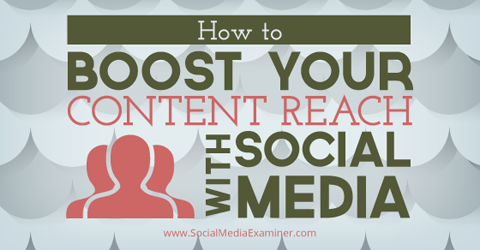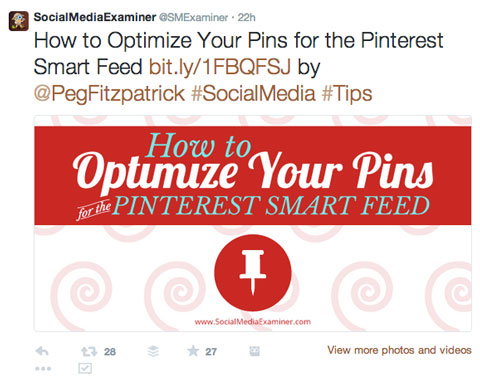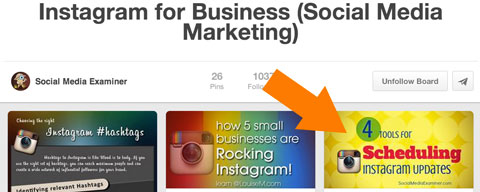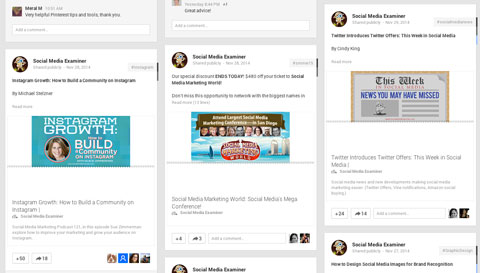 Looking for the best ways to publicize your content?
Looking for the best ways to publicize your content?
Want more social exposure from the get-go?
Sharing on a variety of social media platforms in different ways helps you engage with a variety of audiences.
In this article I'll share posting guidelines you can use to promote your content for the first 24 hours after it goes live.

Listen to this article:
Where to subscribe: Apple Podcasts | Spotify | YouTube Music | YouTube | Amazon Music | RSS
You can also subscribe via RSS, Stitcher and iTunes. How to subscribe/review on iPhone.
Why?
Whether you publish a new blog post, video clip, audio interview or other piece of content, you want to spread the word to your followers as fast and efficiently as possible. While the exact tactics may vary from business to business, the basics for each network remain the same.
First 24 hours: Share the content to Facebook once.
Keep the following guidelines in mind for posting to Facebook.
Try not to post new content more than two or three times in the first week after it goes live.
Within these posts, vary the types of Facebook updates. For example, your first post might be a link post, but your second and third updates might be image posts or video posts, if applicable. This helps you appeal to different audience members, as well as generate data on what types of Facebook posts engage your audience best.

Each time you post, use different copy and preview images. The different link preview elements on Facebook are editable from the image to the headline to the description. Mix and match to test out different scenarios.
To occasionally amp up your visibility, ask your team members and friends to share your business page updates to their personal accounts. This helps broaden your reach and gets your updates in front of people who aren't already following the company Facebook page.
First 24 hours: Share the content three or four times on Twitter. Keep the following Twitter guidelines in mind.
Get World-Class Marketing Training — All Year Long!
Are you facing doubt, uncertainty, or overwhelm? The Social Media Marketing Society can help.
Each month, you’ll receive training from trusted marketing experts, covering everything from AI to organic social marketing. When you join, you’ll also get immediate access to:
- A library of 100+ marketing trainings
- A community of like-minded marketers
- Monthly online community meetups
- Relevant news and trends updates
Don't schedule your “first 24 hours” messages back to back. Instead, break them up with additional updates or retweet content from others.
Use different copy, hashtags and mentions in each update. Don't just repeat the same message. Change it to see what engages your Twitter followers most.
It's okay to retweet other people who share your posts, but don't just leave it at that. Take these opportunities to try to get a conversation going. Also, be aware that you don't completely fill up your feed with retweets and replies.
Alexandra Skey of Spokal estimates that a new tweet only has a lifespan of about two hours, which means followers who don't check their feed regularly are likely to miss your updates.

Although you have the flexibility to post more Twitter updates, you still want to adjust the tweet frequency, so it's in line with the average number of tweets you send in a typical day.

Discover Proven Marketing Strategies and Tips
Want to go even deeper with your marketing? Check out the Social Media Marketing Podcast! Publishing weekly since 2012, the Social Media Marketing Podcast helps you navigate the constantly changing marketing jungle, with expert interviews from marketing pros.
But don’t let the name fool you. This show is about a lot more than just social media marketing. With over 600 episodes and millions of downloads each year, this show has been a trusted source for marketers for well over a decade.
For example, if you average around 10 tweets a day, peppering your stream with three or four messages about a new piece of content won't overwhelm your followers. However, if you only average a few tweets a day, scale back this frequency. That way, your feed doesn't become too self-promotional.
Pinterest and Instagram
First 24 hours: Pin all blog post images to Pinterest or Instagram.
When you publish a blog post, share the visual elements to a relevant pinboard on Pinterest or in your Instagram feed after the post goes live. This will help drive viral interest in your content.
Keep the following rule of thumb in mind:
- Post to Pinterest if your audience tends to be middle-aged or older.
- Post to Instagram if your audience is younger.
Keep an eye on your traffic referral and engagement rates to see if these general trends hold true for your followers.

Post a number of notable images from a behind-the-scenes, how-to or regular article with your audience. Other options: Turn inspirational quotes from the article into images or share content in other formats to Pinterest and Instagram.
First 24 hours: Post content link to profile or long-form blog post.
LinkedIn offers the opportunity to share either short updates in the form of links to content (that you can also tweet) or long-form blog posts in their entirety through LinkedIn Publisher.

Decide how to post on LinkedIn on a case-by-case basis and determine who will post it. Rotating posting duties among senior staff members helps keep things fresh for your readers and lets you reach a wider audience.
When appropriate, post to your company page or in relevant LinkedIn groups.
Google+
First 24 hours: Post content link to company profile and/or Google+ communities.
One of the nice things about Google+ is that the network allows users to post long updates. Therefore, you can either share the full blog post to your company profile or draft a custom long intro and then link back to the newly released piece of content.

Depending on the quality of the content, you may also want to post it to your Google+ communities. Generally, though, you'll only want do this with your highest-quality pieces or with those that you know will perform well with that specific audience.
Conclusion
All social media marketing plans are a little different, so use logic to adjust the guidelines according to your own needs. Trial and error also works wonders to determine what's successful when promoting new content.
Develop a social posting plan to get your content the attention it deserves in the first 24 hours after it's published.
What do you think? Do you have a posting plan in place at your company? What do you do to promote new content on a variety of social networks? Which networks get the most engagement from your audience? Please share your thoughts and advice in the comments below.
Attention Agency Owners, Brand Marketers, and Consultants

Introducing the Marketing Agency Show–our newest podcast designed to explore the struggles of agency marketers.
Join show host and agency owner, Brooke Sellas, as she interviews agency marketers and digs deep into their biggest challenges. Explore topics like navigating rough economic times, leveraging AI, service diversification, client acquisition, and much more.
Just pull up your favorite podcast app, search for Marketing Agency Show and start listening. Or click the button below for more information.

